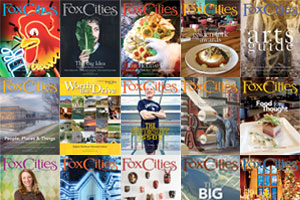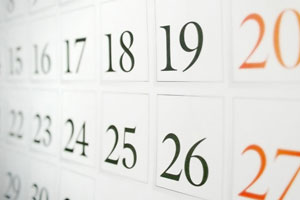The Heart of Art in the Fox Cities
By Siri Pairin
Behind any thriving community exists a strong commitment to the arts that fosters dynamic creativity. This creativity flows through the Fox Cities as tenaciously as the Fox River.
Much like the river’s current, this driving force is not always seen on the surface, but is ever- present and responsible for unique ideas and cutting-edge innovation within the Fox Cities. It encourages free thought and enables expression of humanity.
The heart of this spirit can be found in the collaborative efforts behind the recently renamed Fox Cities Building for the Arts.
“We decided to change the name of the building to the Fox Cities Building for the Arts because it better represented what was going on in the building,” says Pamela Williams-Lime, Trout Museum of Art and Fox Cities Building for the Arts president, “[It] is more reflective of what is happening here and it’s a better way for us to communicate that to the community.”
The building, formerly known as The Reigel Building, The Appleton Art Center, and The Trout Museum of Art was recently rechristened The Fox Cities Building for the Arts and houses five of the Fox Valley’s most prominent arts organizations: Appleton Boychoir, Fox Valley Symphony, Makaroff Youth Ballet, newVoices (formerly White Heron Chorale) and the Trout Museum of Art.
“When the Appleton Art Center became the Trout Museum of Art, a lot of the local community just looked at it as a museum and didn’t really feel they needed to be involved in it anymore, [and that] it wasn’t a community group,” says Michelle Richeson, a local visual artist and Fox Cities Building for the Arts board member.
But the changes extend beyond a name change; new opportunities and more accessible space are in store for all five organizations.
“We are in the middle of a capital campaign to address the needs of all the organizations living in here,” says Williams-Lime.
Often forced to rent space to hold meetings, the organizations residing in the building are now able to use renovated office space on the third floor. The space includes a board room conducive to holding rehearsals, receptions and small performances.
Along with a revamped third floor, renovations to the fifth floor will take place to better address recently kick-started educational programming.
The name change and inter-group cooperation will also serve as a collaborative model for non-profit organizations.
“The capital campaign, in the process of changing from the Trout Museum to the Fox Cities Building for the Arts, was done intentionally to better serve both what we as a non-profit are trying to do, but also to help the other organizations as well,” says Williams-Lime. “We’re talking about a collaborative business model and collaboration between the organizations.”
Kathi Seifert, chairman of the board of the Fox Cities Building for the Arts, says this model will produce and encourage ideas that better define operations within non-profits, whether they are arts-related or not.
“If we work on how more effectively we can work together and share resources or learn from each other, utilizing the same resources could not only save money, [but] provide more efficiency for each and every one of the organizations,” says Seifert.
The increased efficiency and communication between the arts organizations within the building are expected to not only provide an example for other non-profits, but also allow for more joint projects that include multiple, or all, groups.
The Young Audiences Fine Arts Series, one of the first collaborative projects set to run from January through May, will involve all five organizations and aims to introduce families into all areas of the arts. Each organization in the building will stage a 40 minute interactive educational performance for audiences of young children and families. With each performance, audience members will also complete a hands-on arts project relevant to the presentation.
“It’s an example of where we’re looking to collaborate because each of our missions has a piece of education in it,” says Williams-Lime. “You find common threads and you make a bigger presentation instead of each organization programming independently.”
Seifert says more collaborative programs will help increase engagement in the arts by community members.
“The collaborative programming will bring people together and help them not only learn about the arts but have fun, enjoy the arts and feel proud of the different things they can do from a creative standpoint,” says Seifert.
Rebecca Fitton, an alumnus of both the Fox Valley Youth Symphony and Makaroff Youth Ballet, participated in a collaborative performance with the two organizations this past spring.
“Not only did the dancers and musicians learn from the performance, but many community members were entranced by the power of youth artists,” Fitton says.
For Fitton, these collaborations can both involve the community and enhance the arts themselves.
“Different art forms are both naturally intertwined and compliment each other well,” Fitton says. “It makes complete sense to honor their relationship by renaming the building.”
Williams-Lime says she hopes the Fox Cities Building for the Arts collaborations will accentuate this relationship.
“[Art] is woven into everybody’s soul whether they know it or not,” says Williams-Lime. “What we’re trying to do is put a little emphasis on that.”
With fine arts often one of the first programs to be cut in schools, the revamped Fox Cities Building for the Arts can help fill the void and serve as a hub for artists both professional and amateur.
“It really made me think about where I put my money and my time,” says Richeson. “So few people give to the arts and it’s something the whole community does enjoy.”
Along with engaging the community in the arts, the Fox Cities Building for the Arts programming can help foster important skills and allow for creative development among youth.
“It’s so important that we engage our youth in the arts and really help them focus on creativity and problem solving,” Seifert says. “Not only is art something to enjoy, but I truly believe that engaging in the arts encourages creativity, which can in turn encourage innovation, which helps drive the future.”
—FC











Leave a Comment